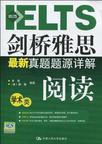剑桥雅思最新真题题源详解
出版时间:2010-4 出版社:中国人民大学出版社 作者:李箐,(澳)杨春 编著 页数:262 字数:402000
Tag标签:无
前言
雅思学术类阅读考试采用的是题库制,在实战考试中,3篇阅读文章都考新文章的概率极低,通常新老文章的比例是2新+1老、1新+2老或3老。而且,根据笔者十几年来教授雅思学术类阅读及数十次亲身参加实战考试的经验,越是重复考过的老文章越容易再次出现。因此,本书收录了近2年重复率较高的真题源文,比如:美国肥胖、龙涎香、海獭、考拉、人类五种感觉、厄尔尼诺现象、计时器发展史、阅读的教学方法、机器人和海底热流排放等多篇文章。 近2年共计有3671名参加环球雅思学校培训的考生在课堂上对由以上文章汇编成的10套题进行了真题源文演练,效果喜人:2007年有162名学员取得了8分以上的成绩并领取了奖学金。我相信,“强者恒强”,这些真题源文在2009年也一定会再次出现,让演练过这些真题的考生真正受益。 对于已经接受过雅思学术类阅读考试正规培训的考生,他们可以直接演练这些由真题源文汇编成的10套高仿真模拟题。对于没有接受过雅思学术类阅读考试正规培训和虽接受过培训但依然对考试摸不着头脑的考生,建议先阅读雅思学术类阅读考试题型和评分标准,以便快速掌握学术类阅读的特点、解题的正确思路和技巧,并精心揣摩套题精解示范,然后再做练习。
内容概要
《剑桥雅思最新真题题源详解:阅读(学术类)》收录了近2年重复率较高的真题源文,比如:美国肥胖、龙涎香、海獭、考拉、人类五种感觉、厄尔尼诺现象、计时器发展史、阅读的教学方法、机器人和海底热流排放等多篇文章。
书籍目录
第一部分 雅思阅读学术类真题题源10套 TEST PAPER 1 PASSAGE 1 口译:同传和交传 PASSAGE 2 生物防治 PASSAGE 3阅读的教学方法 TEST PAPER 2 PASSAGE 1 鲸鱼的文化和语言 PASSAGE 2 看电视上瘾 PASSAGE 3 恐惧研究 TEST PAPER 3· PASSAGE 1 机器人 PASSAGE 2城市规划 PASSAGE 3美国电影 TEST PAPER 4 PASSAGE 1海底热流排放 PASSAGE 2 电击试验 PASSAGE 3 厄尔尼诺现象 TEST PAPER 5 PASSAGE 1 未来汽车业 PASSAGE 2 幽默研究 PASSAGE 3 计时器发展史 TEST PAPER 6 PASSAGE 1 英国天才工程师——伊萨姆巴德·金德姆·布鲁内尔 PASSAGE 2 水坝的灾难 PASSAGE 3 考拉(树袋熊) TEST PAPER 7 PASSAGE 1 美国肥胖 PASSAGE 2 玻璃研究 PASSAGE 3 学术腐败 TEST PAPER 8 PASSAGE 1 选择和幸福 PASSAGE 2 鲸鱼的感觉 PASSAGE 3 语言学派 TEST PAPER 9 PASSAGE 1 地图发展史 PASSAGE 2 仿生学研究 PASSAGE 3 人类五种感觉 TEST PAPER 10 PASSAGE 1 海獭 PASSAGE 2 龙涎香 PASSAGE 3 社会学试验第二部分 雅思阅读学术类2套模拟试题 TEST 1 TEST 2第三部分 附录附录1 2007年8月-2008年8月中国考区雅思考试阅读学术类文章汇总附录2 单词总表
章节摘录
C Classical biological control is the introduction of natural enemies to a new locale where they did not originate or do not occur naturally. This is usually done by government authorities. In many instances the complex of natural enemies associated with an insect pest may be inadequate. This is especially evident when an insect pest is accidentally introduced into a new geographic area without its associated natural enemies. These introduced pests are referred to as exotic pests and comprise about 40% of the insect pests in the United States. Examples of introduced vegetable pests include the European corn borer, one of the most destructive insects in North America. To obtain the needed natural enemies, scientists turned to classical biological control. This is the practice of importing, and releasing for establishment, natural enemies to control an introduced (exotic) pest, although it is also practiced against native insect pests. The first step in the process is to determine the origin of the introduced pest and then collect appropriate natural enemies associated with the pest or closely related species. The natural enemy is then passed through a rigorous quarantine process, to ensure that no unwanted organisms (such as by per parasitoids) are introduced, then they are mass produced, and released. Follow-up studies are conducted to determine if the natural enemy becomes successfully established at the site of release, and to assess the long-term benefit of its presence. D There are many examples of successful classical biological control programs. One of the earliest successes was with the cottony cushion scale, a pest that was devastating the California citrus industry in the late 1800s. A predatory insect, the Vidalia beetle, and a parasitoid fly were introduced from Australia. Within a few years the cottony cushion scale was completely controlled by these introduced natural enemies. E Damage from the Alfalfa weevil, a serious introduced pest of forage, was substantially reduced by the introduction of several natural enemies. About 20 years after their introduction, the population of weevils, in the alfalfa area treated for alfalfa weevil in the northeastern United States, was reduced by 75 percent.
图书封面
图书标签Tags
无
评论、评分、阅读与下载
用户评论 (总计16条)
- 很好的雅思阅读题源,很大的帮助作用
- 不错,剑桥雅思和别的书就是不一样,要考的同学们极力推荐,有点小贵!
- 主要针对阅读和写作的。
- 阅读量挺大的,对扩充词汇和提高阅读很有帮助,质量不错,拿在手里很有质感~~
- 阅读很好的书
- 感觉是很有用的一本书啦,印刷和质感非常舒服
- 质量不错,有附录单词什么的,挺详细的
- 買來以後,還沒有讀。
可是,學術類的閱讀練習本來就不多,能夠找到一本,就覺得不錯了。 - 对于了解背景,扩充词汇量很有好处!很好的练习册,到货很快!
- 从质量来说这本书很不错,绝对正版,不过呢好像对考雅思帮助不大,题目和真题什么的不是很相近。
- 整体不错,就是纸质有点不好。不影响阅读!!!
- 帮朋友买的,不太了解
- 还没仔细去读,大概浏览了一下,貌似只有题目,没见到详解啊,等我仔细度过之后,如果感觉变了,再重做评论
- 答案不详细,只能当课外阅读!
- 适合泛读,看些背景知识倒是有些用啦,但老实说,对做题用处不大,泛泛来看,或是只是学词汇倒还可以用
- 这本书还挺好的。但要有耐心
推荐图书
- 中国城镇发展研究
- 中国近代舰艇工业史料集 (精装)
- 中国农民土地持有产权制度新论
- 股票交易创新技法图解
- 财会员手册 (平装)
- AutoCAD 2009实例教程与疑难解答
- Flash CS4网络动画制作简明教程
- Flash 8动画基础案例教程
- 微机维修技术 (平装)
- 谬误大观 (精装)
- 沙漠探奇
- 征农教育论文选 (平装)
- 建筑工程管理微机软件及应用 (平装)
- 学业管理与评价研究再探 (平装)
- 家具表面装饰工艺技术
- 成功的面谈
- 社会保障速查手册
- 淳化阁帖 (平装)
- 沈柔坚版画选集 (平装)
- 任薰龙王礼佛图卷 (平装)
- 古今名人画谱 (平装)
- 五四运动 (平装)
- 督军团传 (平装)
- 戊戌风云
- 敦煌俗字研究 (平装)
相关图书
- 剑桥雅思最新真题题源详解
- 金瓶梅研究(第九辑)
- 咔咔!我是日语单词书
- 上海监狱人权记录
- 国际反恐法律文件汇编
- 法律基础
- 精神文明与法制 (平装)
- 新编食品安全法律手册
- 中华人民共和国刑法实用手册
- 煤矿安全生产和个体防护实用手册
- 药补不如食补
- 进补奥秘 (平装)
- 老年人心理问题诊断
- 国际产业转移论 (平装)
- 现代市场经济常用语手册 (精装)
- 产业经济学 (平装)
- 现代经济增长中的结构效应 (平装)
- 企业税制优化论 (平装)
- 实用机械设备电动机控制电路
- 水表装修工 (平装)
- 经济法基础理论文献辑要(第1辑)
- 村镇建设统计实用指南 (平装)
- 科技塑造未来城市 (平装)
- 上海城市建设和管理 (平装)
- 城市房屋拆迁管理 (平装)
